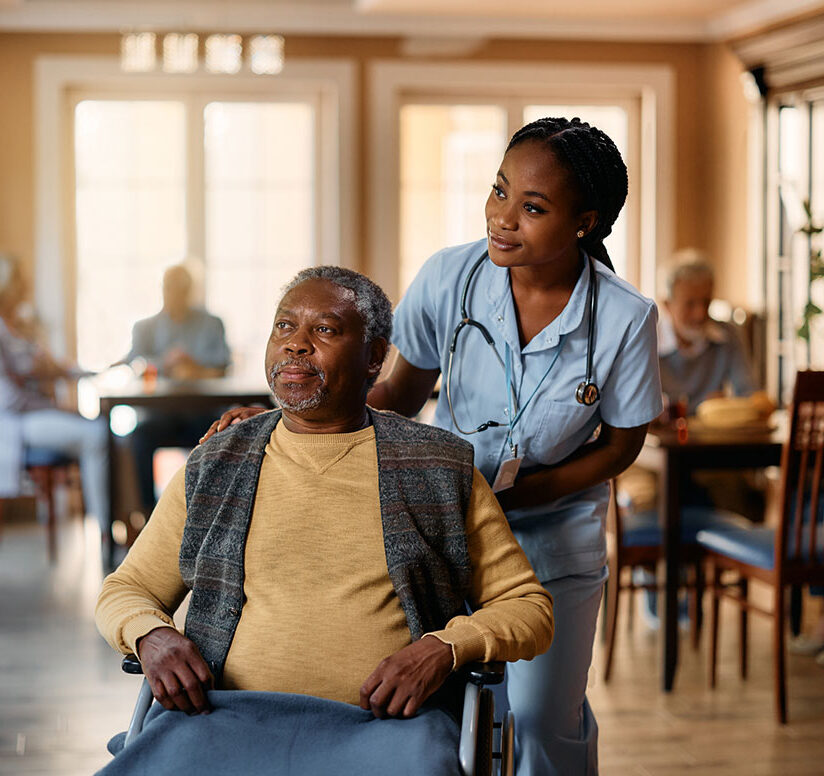CDC Updates Health Care Settings Recommendations, Retires Nursing Home-Specific Guidance
The Centers for Disease Control and Prevention (CDC) released long-awaited updates to COVID-19 recommendations for health care settings on September 23. While still not aligning with recommendations for the general public, the updated recommendations provide greater flexibility for individuals living and working in health care settings than previous guidance. CDC has also retired the nursing home-specific guidance that recommended more stringent mitigation measures for nursing homes than other healthcare settings, though additional considerations for nursing homes and other special settings are included in the updated healthcare setting guidance. The recommendations take effect immediately and the Centers for Medicare and Medicaid Services (CMS) has accordingly updated nursing home requirements and sub-regulatory guidance through memo QSO-20-38-NH and memo QSO-20-39-NH.
High-Level Changes
Health care settings will continue to use Community Transmission Rates to inform infection prevention and control practices rather than the COVID Community Levels utilized by the general public. Using community transmission rates allows providers to adjust interventions earlier, mitigating the strain on the healthcare system and protecting the vulnerable individuals seeking care in health care settings. CDC recommends that health care settings check community transmission rates on a weekly basis to best determine infection control practices based on current conditions.
Health care setting recommendations will no longer be based on vaccination status. Mitigation measures such as source control, quarantine / work restriction, and screening testing will be the same for all individuals in applicable circumstances, regardless of whether the individual is or is not up to date with COVID-19 vaccination.
Screening of Staff and Visitors Entering the Health Care Setting
CDC no longer recommends active screening of staff and visitors entering a health care setting for COVID-19 symptoms or exposure. Active screening means monitoring those entering the health care setting by use of a live person or assistive technology such as electronic monitoring systems and applications. Health care settings may opt to continue active screening or may revert to the use of passive screening techniques, such as signage describing the symptoms of COVID-19 and advising against entering the healthcare setting should the staff member or visitor experience symptoms or exposure. Nursing home staff should additionally be instructed to report to occupational health or another contact designated by the nursing home any symptoms of COVID-19, positive SARS-CoV-2 test results, or high-risk exposures.
Source Control
Health care settings will continue to utilize community transmission rates to inform source control decisions. Source control, including a respirator or well-fitting face mask, continues to be recommended for all individuals in a healthcare setting including staff, residents/patients, and visitors, when the healthcare setting is located in an area of high community transmission. The use of eye protection as source control is at the discretion of the health care facility. CDC states that staff in areas of high community transmission may remove source control in spaces that are inaccessible to residents/patients if COVID Community Levels are not also high; however, if COVID Community Levels and Community Transmission Rates are both high, staff must continue to use source control at all times in the health care setting.
Additionally, source control is recommended regardless of community transmission rates for individuals who:
- Have a confirmed or suspected respiratory infection. This includes respiratory infections that are not COVID infections, such as cold or flu.
- Have had close contact with someone with SARS-CoV-2 infection until 10 days after exposure.
- Reside or work in an area of the health care setting experiencing a SARS-CoV-2 outbreak. Remember, an outbreak is still defined as a single case of COVID-19.
- Have otherwise had source control recommended by public health.
Universal source control is no longer recommended in healthcare settings in areas of substantial, moderate, or low community transmission except for individuals who meet the above criteria. This means that staff may perform care without the use of eye protection or a well-fitting face mask if they are in areas of substantial, moderate, or low community transmission and the above-criteria are not met.
CDC states that individuals should always be permitted to wear source control according to their preferences, even when not otherwise required by the healthcare setting. Health care settings in areas of high community transmission also may consider implementing staff use of N95 or similar respirators for certain situations such as aerosol-generating procedures and eye protection during patient care encounters, though this is a consideration, not a recommendation.
Asymptomatic Screening Testing
CDC no longer recommends routine screening testing of asymptomatic health care personnel based on community transmission rates. CMS has updated nursing home testing requirements at memo QSO-20-38-NH accordingly. Nursing homes must continue to adhere to state laws, including any states that require routine screening testing of staff. Additionally, these updates to CDC recommendations do not supersede individual nursing home policies where routine screening testing may be required as an “additional precaution” for individuals who have received exemption from COVID-19 vaccination. The nursing home may adjust its policies as it sees fit.
Testing Due to Exposure
A series of 3 tests is recommended for individuals in health care settings (residents/patients and staff) following SARS-CoV-2 exposure, regardless of the individual’s vaccination status. Asymptomatic residents/patients who have had a close contact exposure and staff who have had a high-risk exposure should be tested immediately (but generally not earlier than 24 hours after exposure) on Day 1 post-exposure. Negative tests should be repeated in 48-hour intervals, on Day 3 and Day 5 post-exposure.
CDC also recommends a series of 3 tests for individuals newly admitted or readmitted to the nursing home in areas where community transmission rates are high. These individuals would be tested on the day of admission (Day 1), with negative tests repeated at 48-hour intervals on Day 3 and Day 5 post-admission. In areas where community transmission rates are not high, testing of new admission/readmissions is at the discretion of the nursing home.
CDC has updated testing recommendations around individuals who have previously recovered from COVID-19. Individuals are not recommended for asymptomatic screening testing if they have recovered in the past 30 days, as opposed to previous recommendations to refrain from testing for 90 days. If individuals who have previously recovered from COVID-19 in the past 30 days must be tested, CDC continues to recommend utilizing antigen tests for these individuals. CDC additionally recommends utilizing antigen tests when testing individuals who have recovered from COVID-19 in the past 31 -90 days.
Quarantine and Work Restriction
Quarantine is no longer recommended for asymptomatic residents/patients or visitors to health care settings following exposure. CDC also no longer recommends quarantine of asymptomatic new admission / readmissions to the nursing home. Health care personnel with high-risk exposure are generally no longer recommended to be restricted from work provided they remain asymptomatic and do not develop symptoms. Work restriction of asymptomatic health care personnel may be considered in some circumstances outlined in the Interim Guidance for Managing Health Care Personnel.
Individuals who have been identified as having been exposed to SARS-CoV-2 and new admissions / readmissions to nursing homes in areas of high community transmissions should continue to monitor for symptoms, complete a series of 3 screening tests as outlined above, and wear source control for 10 days following exposure or admission. Individuals should be promptly isolated or restricted from work if symptoms develop or testing is positive for SARS-CoV-2 infection.
Isolation / Work Restriction for Suspected or Confirmed COVID-19
Recommendations for the duration of isolation of residents or work restriction of health care personnel have not changed. Individuals who test positive for COVID-19 should be isolated in their rooms or restricted from work for a period of 10 days. Staff may return to work after Day 7 with a negative viral test. Return to Work recommendations can be reviewed here. Providers should take note that CDC has clarified expectations around designated COVID units and staffing. Dedicated COVID units and staffing could be considered for managing residents/patients with SARS-CoV-2 infection in situations where staffing crises are not present and case numbers are high. In situations where staffing crises are present or the number of cases is low, residents/patients can remain isolated in place, ideally in a private room. Cohorting continues to be recommended only for those with the same respiratory pathogen. Recommendations for the use of personal protective equipment in caring for these individuals remains unchanged.
Outbreak Response
CDC recommendations for outbreak response in nursing homes remain unchanged. Nursing homes may elect to conduct outbreak testing based either on contact tracing or a broad-based approach that tests all individuals on the affected unit or all individuals living and working in the nursing home. CDC recommends that if ongoing transmission is identified, nursing homes should consider implementing quarantine / work restriction for those identified with close contact or high-risk exposure and testing should be expanded to a broad-based approach if not already in use.
What This Means for Members
LeadingAge is pleased with the updated recommendations from CDC that reflect our advocacy on behalf of our members and the autonomous individuals they serve. It is our hope that CDC and CMS will continue to evaluate these recommendations and find balance between the safety and the wellbeing of the residents and staff in nursing homes and other health care settings. However, we caution members to check state requirements prior to implementation, noting that many states have written specific health care setting or nursing home requirements based on CDC recommendations and will need to decide whether these requirements will be adjusted to reflect the new recommendations.
Additionally, we note that with these new recommendations, CDC now offers assisted living the flexibility to determine whether the residents and staff are better served and protected by following healthcare setting recommendations or the more flexibility congregate care setting recommendations. Once again, this will be an area in which members will need to look to the state for direction.

Most Recommended
October 15, 2025
 Shutdown Week Three: Impact of Ongoing Closure on Affordable Housing
Shutdown Week Three: Impact of Ongoing Closure on Affordable Housing
November 13, 2025
Fiscal Year (FY) Funding 2026
October 07, 2025
Immigrant Workforce Matching Program Brings Workforce Relief
Recently Added
November 21, 2025
HUD Assistance Associated with Earlier Cancer Diagnosis
November 21, 2025
HHS Launches $2 Million AI Prize to Support America’s Caregivers
November 19, 2025
Administration Seeks to Shift Immigration Policies on ‘Public Charge’
November 17, 2025



